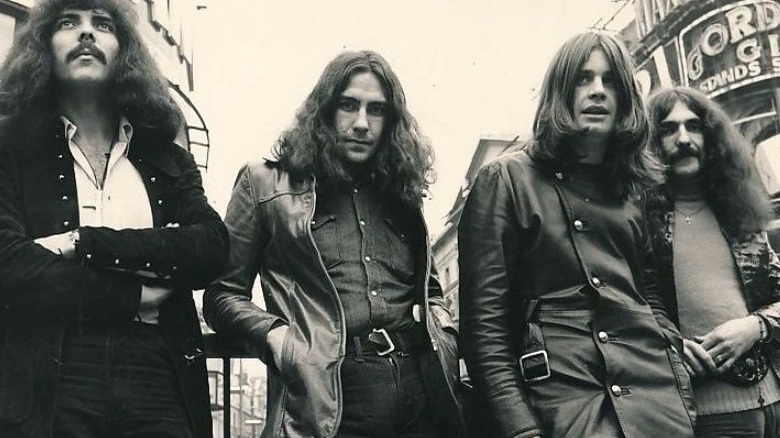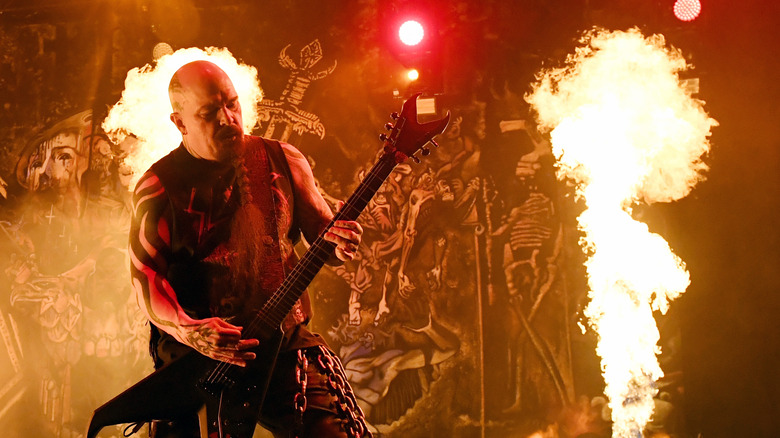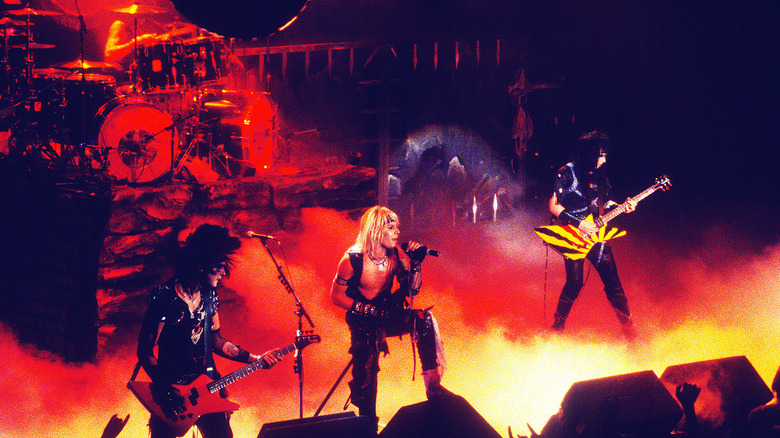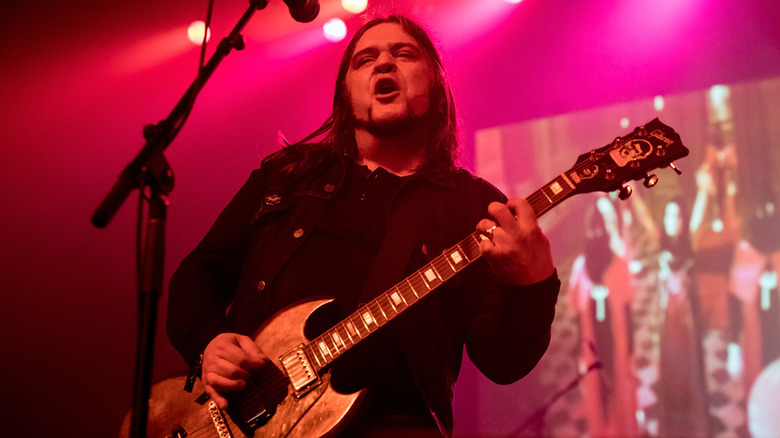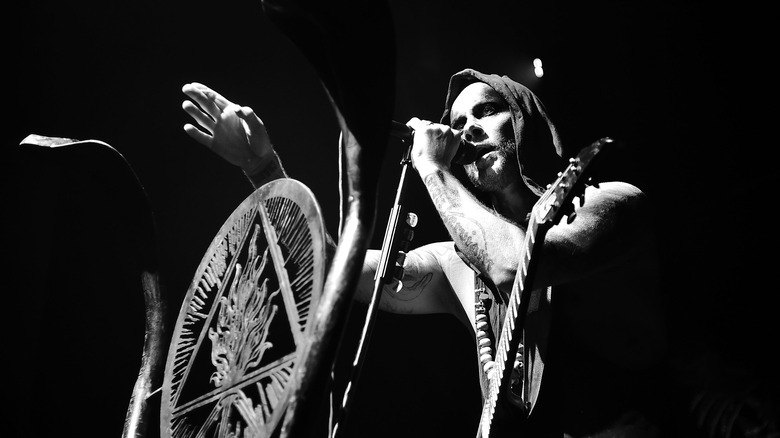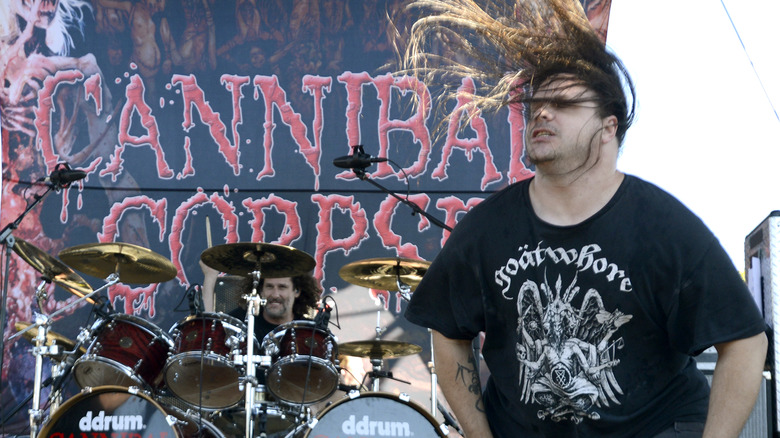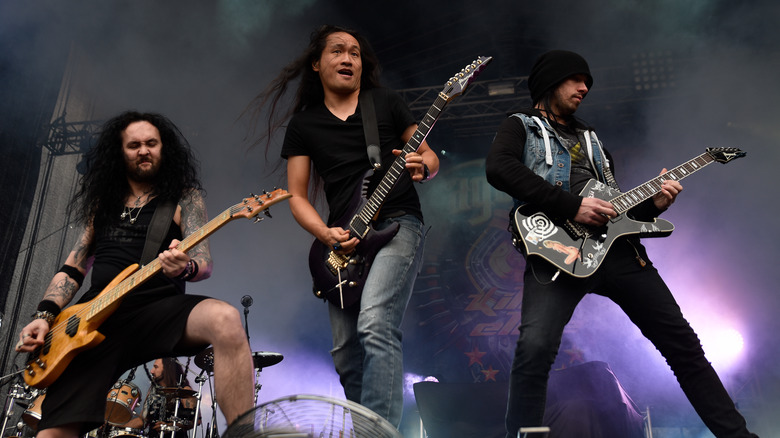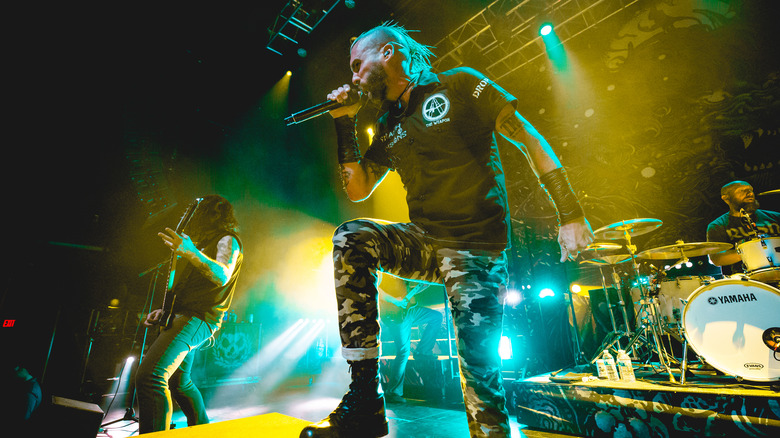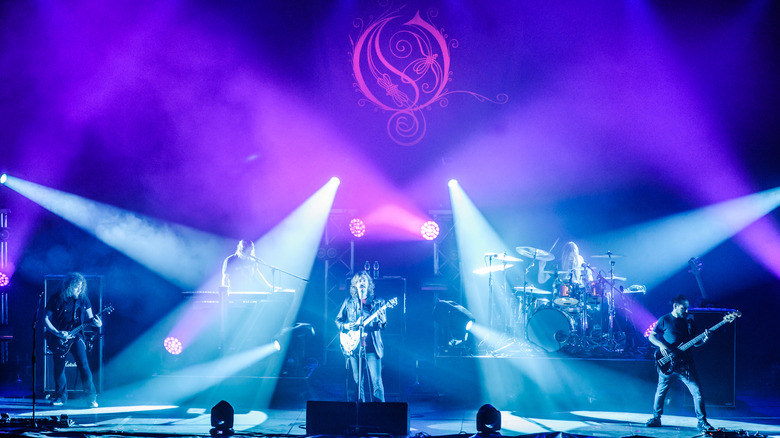Metal's Popular Subgenres Explained
Metalheads are used to rampant misunderstanding of their music. True metalheads learned long ago to simply roll their eyes at the myriad of unaware claims levied against them and the headbanging community at large: "you're a pox on polite society"; "you worship the devil"; "you're all just so, so angry, have you ever listened to Katy Perry?" (causing actual anger in the process); and many more long-tired claims. Speaking on behalf of all metalheads, "Please go away. I'm too busy listening to a chonky riff."
Chronic societal misunderstanding of metal, on a whole, boils down to a lot of factors. Musicians are often virtuosic, and the complexity of their instrumentation requires close, focused listening. Harsh vocals and dark tones can put some people off, too. "Metal" also constitutes an immense, deep variety of distinct, niche subgenres, like vintages of wine. Many of these are nested subgenres built on in-group musical terminology, which can be imposing to new listeners.
There are about 10 quadrillion metal subgenres that we're not going to touch on in this article, like pirate metal, pornogrind, Indian folk metal, noisecore, black n' roll, jazzcore, and loads of other "cores." Also, we're not going to talk about labels rendered meaningless by time, like "alternative metal" (something like Tool circa mid-1990s). And to disappoint all those Limp Bizkit listeners out there, both serious and ironic: this one sentence is the only time you're going to read about nu-metal.
Dude, that's like, so heavy
You might be wondering, "Who cares about labels, anyway? If you like it, you like it. That's art." Ding ding, you win — lots of metalheads feel the same way. Others, though, will garrote you in your sleep over the sanctity of difference between something like "blackened death metal" and "post-blackened proto-death emo-metal" (the latter is fictional, we assume). The truth is, for the sake of discussion, analysis, and the ease of introducing folks to metal, specific genre divisions can be helpful.
Take heavy metal, one of the most foundational and misunderstood types of metal. "Heavy metal" often gets used interchangeably with straight-up "metal," which isn't correct. Lots of "heavy" metal doesn't even sound truly heavy to the modern ear, which has gotten accustomed to more and more extreme versions of tuned-down, chugga-chugga, drop-B, noise-interlaced mixing. Heavy metal means classic bands like Led Zeppelin, Deep Purple, and Judas Priest, contemporaries of the Ozzy Osborne-led metal progenitors themselves, Black Sabbath, formed in Birmingham, England, in 1968.
At the time, heavy metal began as an experimental hodgepodge of musical influences, including blues and the trashy, distorted tones of early rock bands like The Kinks (e.g., "You Really Got Me" in 1964), via Teach Rock. The term "heavy metal," as Live About says, was first used in the 1968 Steppenwolf song "Born to be Wild." Why heavy? "Heavy" was '60s slang for serious or deep, which highlighted the music's willingness (at times) to dive into important social issues.
Headbangers unite: the thrash man cometh
Even if the general public doesn't know the term "thrash," thrash is one of the more widely recognizable types of metal. It's managed to grab mainstream attention thanks to musical mainstays like Metallica and crossed generational gaps to inspire the present, 40 or so years after its heyday. Metallica is one of the "Big Four of Thrash," which includes Megadeth, Slayer, and Anthrax, as Spinditty explains.
Thrash is a pretty easily identifiable subgenre that splintered off from "speed metal" in the 1970s. We're talking high BPM (beats per minute, i.e., tempo), lots of downpicking (rather than up-and-down strumming), minor keys, muscular riffs, "shredding" guitar solos, and sometimes double kick drums. The lighter side of thrash, something like Anthrax's "Madhouse" (1985), could be mistaken for '80s glam or hair metal (more on that later), which admittedly influenced some thrash bands' aesthetics and music. The heavier side of thrash is, well, Slayer. One single listen to the first, absolutely brutal, tritonal minute of "Raining Blood" should illustrate as much.
Thrash metal took off with the "Big Four" in the early 1980s, and strictly speaking, it died out as a distinct form of metal by the end of the decade. Its heralds, though, lived on. That's not to say that every song by the "Big Four" is strictly thrash (Metallica's "Nothing Else Matters" is an obvious example), but all in all, these bands came to define the sound and leave a permanent sonic mark.
Grab your lipstick and glam it up
This choice is going to draw the ire of folks who prefer their metal ultra-heavy and with less lipstick, but yes, glam has its place in metal history. Glam has a fairly complex but short history that started with non-metal artists like David Bowie in the early 1970s. Bowie dove into the aesthetics of his art, wielding costumes and full-on makeup. Personas like the "omnisexual alien rock star" (per Rolling Stone) Ziggy Stardust and Bowie's iconic, blue-and-red-lightning-slashed "Aladdin Sane" makeup illustrated a countercultural shift towards performance art and Oscar Wildean, over-the-top sumptuousness.
Blow this glitter all over '70s rock, and you wind up with bands like arena rockers KISS, Van Halen, possibly Aerosmith and Quiet Riot, and even punk legend Alice Cooper (via Beat). There's some interplay between heavy metal, punk, hard rock, etc., but come the early- to mid-1980s, glam went full arena — Mötley Crüe, Twisted Sister, Poison, Cinderella, and more represent an evolution from glam metal into what's been dubbed "hair metal," as East of Borneo describes. Meanwhile, the aforementioned thrash dug in its surlier, burlier heels and went harder, darker, faster, and so on.
Glam might have died as a distinct subgenre, but its ethos lived on in metal musicians like (for better or worse) Marylin Manson, who also grafted gothic and industrial elements into his sound. On the non-metal side, performative artists like Lady Gaga also owe a big debt to the glam era.
Slow it down and go all doom
Doom metal is our final, direct descendant of heavy metal, along with sludge metal, stoner rock, desert rock, and related psychedelia. All retain the same basic elements: a low-tempo, thick soundscape of meditative phrases with plenty of sustained tones and rough production. As The Register-Guard says, doom metal is essentially psychedelic rock with some extreme elements picked up over time. Black Sabbath's classic "War Pigs" and its languorous, groovy, grinding intro perfectly illustrates where doom came from.
Bands like Pentagram and Cirith Ungol kicked off the subgenre in the early '70s, followed by Witchfinder General and Pagan Altar in the late '70s, Candlemass in the '80s, all the way to newer offerings like Electric Wizard, Sub Rosa, Pallbearer, and more. At first, doom adopted some of the same occult iconographies as black metal (more on them later) and was steeped in the "disgusting truth" of humanity's darker, destructive habits (via Michigan Daily).
More recently, doom has begun veering back towards its more general, stoned roots. The Atlantic correctly points out doom's secret sauce: it's essentially transcendental New Age music with dense guitar work and distortion. At present, it's even branched into a brighter, "spaced-out" spiritual cousin in the form of groups like Om, Samsara Blues Experiment, and Villagers of Ioannina City. These groups shed the grimier elements of doom and espouse a trance-like, trippy-hippie sound meant to reflect the quest for human purpose.
Black like my soul
Now we turn to the kind of metal that makes certain religious folks reach under their pillows for their crosses. "Satanic," "occult," "pagan:" these are the kinds of words that have been applied to black metal. And to be fair, it's not only easy to make that assessment — it's usually what the artists intend. We've got shrieking and growling vocals, extreme dissonance, thick chords, heavily textured and deliberately lo-fi mixing, lots of creepy face make-up and stage dressing, and yes, overtly anti-Christian lyrics. The whole subgenre grew out of a mixture of thrash, heavy, and speed metal.
As Masterclass outlines, black metal has cultural roots in Scandinavia in the late 1980s through early 1990s. Norwegian bands like Mayhem, Emperor, and later Darkthrone and Satyricon passed the baton to Bathory in Sweden, Cradle of Filth in the United Kingdom, Behemoth in Poland, Rotting Christ in Greece, and many more. Like a lot of music, black metal came in waves. Second-wave "True Norwegian Black Metal" grew out of the suicide of Mayhem lead singer, Per Yngve Ohlin, which caused the Norwegian metal community to come together in what they referred to as "The Black Circle" (per Life in Norway).
As The New York Times discusses, black metal has been likened to a "cryptic expression of Roman Catholicism" — an oppositely-faced preoccupation not with the divine, heavenly perfection but the unavoidable decay and hatreds of the earthly realm. Its imagery tends to focus on "the abiding and transcendent: stone, mountain, moon."
Death, blood, guts, and whole lot of kick drums
When speaking to non-fans, death metal is the line where most metalheads have to toss up their hands and say, "Okay, okay, hear me out. I know they're singing about murder, torture, dissections and live eviscerations, brutality, torment, death, and the horrors of the grave, but I don't know, it just gives me the warm-glowies inside." Death metal, so-called polite society's ultimate no-fly zone, is characterized by the most extreme of extreme styles: super harsh tone, super growly voice, super savage aesthetics, super deep tones, super explicit lyrics, all super drowning in blood.
Death metal was birthed in the early-to-mid 1980s. As Loudwire explains, we have bands like Death and Possessed to thank for officially siring the subgenre, which was influenced by the thrash revolution, particularly Slayer's aggression and speed. The early crop of death metal bands — Obituary, Morbid Angel, Deicide, Atheist, and more — sprouted up in Tampa, Florida, of all places. From the fuel of tracksuits, gators, Disney, sweltering heat, and unexpressed violence, death metal spread as a movement that wielded virtuosic musicianship to tap into absolute primality.
As The Conversation and Loudwire describe, death metal has been the subject of psychological studies seeking to understand its effects on people and whether or not it really engenders violence, as parents in gated communities fear. Lo and behold, because of their musical outlet, Frontiers in Human Neuroscience suggests that listeners of death metal are usually happier and more even-keeled than not.
The power of fantasy and whammy bars
Time to swerve away from metal's darker side into its bright, major-chorded theater of anthemic fantasy and self-aware silliness. Power metal is sometimes regarded as metal's nerdy, occasionally cringe younger brother who gets dragged out of his Dungeons and Dragons-themed basement just for the family to brag about his last really good test score. High tempos, dueling guitars, super powerful and soaring melodies, a triumphant attitude, absolute showmanship, overly dramatic (and often nasal) vocals: these are the hallmarks of power metal.
As Loudwire explains, power metal can trace its origins back to Black Sabbath-era '70s heavy metal by way of Iron Maiden, Judas Priest, and untouchable vocal legend Ronnie James Dio, Sabbath's post-Ozzy Osborne vocalist (before Ozzy came back). Just have a gander at some of the swords-and-sorcery phrases from "Neon Knights," the very first track off Sabbath's Dio-led, 1980 album "Heaven and Hell." The lyrics include mentions of "dragons and kings," "legions of the brave," "weaving a charm," "protectors of the realm," and more. Since then, power metal bands have only leaned more heavily into magical, Tolkienesque imagery and abstractions.
These days, bands like DragonForce, Blind Guardian, Helloween, and Sabaton lead the power metal march. Each plays its own variation, such as DragonForce's recently adopted neo-'80s neon pastiche and Sabaton's limitless preoccupation with tales of actual, historical warfare. Meanwhile, following in the footsteps of Led Zeppelin vis-à-vis "Immigrant Song," power metal subset "Viking metal" features gloriously self-aware, Norse-themed bands like Brothers of Metal.
Conductors, grab your batons
Take the crunch of metal, add a sweeping orchestral score with operatic vocals, and amp up the fantasy to maximum, and boom: you've got symphonic metal. Indeed, symphonic metal is the most obvious evidence of the old and well-known connection between the compositions of metal and classical music (as the CBC explains).
Similar to power metal, symphonic metal often dives into fantasy-related imagery, and songs often describe self-contained, epic narratives told in a grand fashion. Symphonic metal officially took root in the mid-90s with Swedish outfit Therion, as Symphonic Metal describes. Their early discography started as something closer to Scandinavian-birthed black metal, and by 1996's "Theli," it had mutated into the full-on choral style that still typifies symphonic metal. Also of influence was the track "Yeah! Yeah! Die! Die! Death Metal Symphony in Deep C" by Finnish outfit Waltari.
Much of the credit for the spread of symphonic metal goes to its mainstay, Finland's own cherished Nightwish. Albums like "Oceanborn" (1998), "Wishmaster" (2000), "Century Child" (2002), and more not only concretized the subgenre's sound but also established female-led, soprano or mezzo-soprano vocals as the norm. Bands like Within Temptation and Epica (both from the Netherlands) and the male-led Kamelot (from Tampa, death metal's home turf) picked up the baton and developed the subgenre further. Like a lot of more theatrical subgenres, symphonic metal and its sumptuous emotionality tend to be vastly more popular in Europe and Latin America than elsewhere.
So, so much core
Like glam, this choice is 100% going to irk some metal purists (they're a testy lot). But the truth is, anytime you hear big vocal switch-ups between "dirty" (harsh growling) and "clean" (regular singing) and deep rhythmic shifts between verses and choruses (one riffy and the other melodic), you're looking at the lineage of metalcore. And since it seems that practically every metal band formed since the mid-2000s — including prog- and post-metal bands (more on them later) — have required their vocalists to have the insane range required by metalcore, we'd be completely remiss not to discuss the subgenre here.
Metalcore, as a distinct subgenre, is hard to pull apart from the greater, late-'90s to early-'00s music movement that spawned it, dubbed "American New Wave," "The New Wave of American Heavy Metal," etc., as Kerrang discusses. A whole slew of bands defined this era, each with varying degrees of staying power, and each of whom had to evolve past their peers or vanish: Slipknot, Trivium, Killswitch Engage, As I Lay Dying, The Dillinger Escape Plan, Hatebreed, Shadows Fall, Lamb of God, Avenged Sevenfold, and more.
Metalcore takes cues from a lot of different existing genres, particularly death metal and heavy metal, and fuses them all with a new kind of technical yet muscular playing, chunky chords, and the aforementioned vocal variations. At their heart, all these bands share the same fundamental desire to mix the metallic with the sneering heart of "hardcore," so to speak.
Time signature per math = error
Progressive metal, or prog, is as difficult to define as it is easy to identify. Here are a couple clues: Is the track over 15 minutes long? Probably prog. Does it flip within two seconds from gorgeous pianos and mellow instrumentation to jagged and jarring guitars slashed with ragged vocals? Probably prog. Most pointedly, is it Opeth or Dream Theater? There you go.
Prog is "progressive" for the exact reasons that make it hard to pin down: numerous musical influences, a protean style that shapeshifts between bands' albums and even tracks, polyrhythmic drumming and instrumentation, time signatures that change from minute to minute, and so on. Just listen to absolutely anything by Between the Buried and Me (right around minute two of "Never Seen / Future Shock" comes to mind) to understand. Some might say, "Why cram 50 songs into one song?" Others reply, "Because it's prog, don't you get it?" At its most extreme form, prog more or less becomes "post-metal" because it's gone past its original genre definitions.
As Metalstorm rightfully points out, the roots of prog go back to the experimental music of the 1960s — like Iron Butterfly and King Crimson — and then bands like Rush in the '70s. Keep those band's more eccentric elements, ball them up with every subsequent metal era, toss a huge heap of nigh-academic music theory and sound engineering, and presto: instant TesseracT, Animals as Leaders, Symphony X, and more.
No less than seven strings, please
Finally, we come to a subgenre that wouldn't exist without the foundation of all preceding subgenres: djent (the "d" is silent). Djent borrows bits and scraps from any and every piece of metal before it and synthesizes them into a new, groovy alloy. Djent is oddly rhythmic, sometimes veering towards proggy hip-hop or jazz. It almost always uses severely detuned riffs and a highly syncopated rhythm section (bass and drums). Djent often employs seven-string guitars (not traditional six-string guitars) for a deeper register and greater variety of tunings, a setup first employed by 1960's swing and jazz guitarist George Van Eps, via The New York Times.
Strictly speaking, djent is an offshoot of prog metal. It's highly technical, demonstrates the same high degree of expertise in composition and execution, and might use the same "clean-dirty" vocal paradigm seen in metalcore. Beyond this, definitions are still in the air because the whole thing is still evolving. That being said, djent is not strictly "new," even though it's only picked up steam within the past decade. Swedish band Meshuggah is often credited with birthing djent, down to its moniker. As DjentHub explains the tale, Meshuggah guitarist Fredrik Thordendal inadvertently gave the subgenre its onomatopoeic name, saying during a recording session of their 1991 album, "Contradictions Collapse," "We want that dj- dj- dj- sound." Bands like Periphery and Sikth helped popularize the style, while bands like Ukrainian virtuosos Jinjer hold the torch high today.

